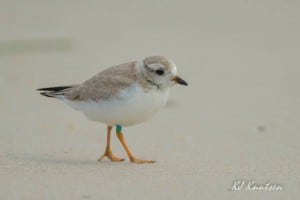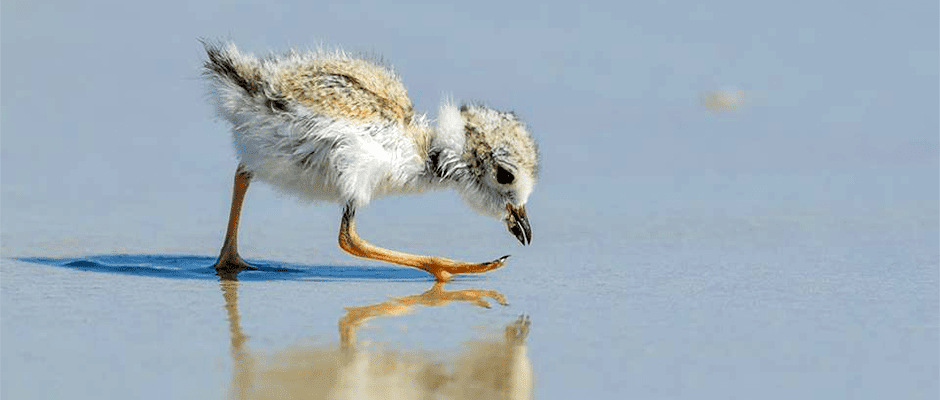Share this article
Plover chicks survive harrowing adventures to fledge on new beaches
From New Jersey to Manitoba, young piping plovers (Charadrius melodus) are learning to fly on beaches that haven’t seen plover nests in years. The birds’ expansion to new beaches is good news for the federally listed species, and it reflects hard work by wildlife professionals to keep the chicks from being crushed or eaten.
Piping plovers were added to the U.S. endangered species list in 1986, largely due to human impacts on the sandy beaches where they nest. Hatchling piping plovers spend about a month foraging on the shoreline, with no defense except to freeze or scamper away on oversized legs. They are especially vulnerable in today’s landscape, with humans crowding beaches and attracting predators such as gulls and raccoons. Plovers usually lay four eggs at a time, and biologists struggle to help them survive.
“If we fledge one chick, we’re happy,” said Christina Davis, an environmental specialist with the New Jersey Division of Fish and Wildlife. “If you fledge three and four chicks, that’s, like, bazonkers.”

This piping plover survived an injury and a brush with a fox before it could fly. Now, the fully fledged bird appears to have grown into its legs. ©KJ Knutsen
At least one chick this year almost certainly would have perished without the efforts of Davis and her colleagues. It hatched at Island Beach State Park in New Jersey, on a beach where piping plovers hadn’t nested in a quarter of a century. When managers learned about the nest, they set up protective fencing and banned motorized vehicles from the area. Nevertheless, three weeks after the chicks hatched in early July, only two remained. One had started to limp.
The biologists debated whether to bring the injured chick to a wildlife rehabilitator. When they captured it for banding, they found that it weighed much less than its healthy sibling. But the chick, which was peeping madly in the biologists’ hands, didn’t have any treatable injuries. They released it, then immediately changed their minds when they saw how badly it was limping. They recaptured it just as a new danger surfaced.
“A red fox popped out over the end of the dune, heard the chick in distress, was like ‘great, this sounds like breakfast,’ and came zooming over,” said Davis.
One person distracted the fox, while another fled with the chick. Then, a rehabilitator ensconced the chick in an incubator with all the food it could eat. It rejoined its family five days later, and fledged with its sibling in early August.
“It was a rollercoaster,” said Davis. “But a very, very happy ending.”
Other success stories this year come from Canada’s Manitoba province, where plovers fledged for the first time since 2010; Lower Green Bay in Wisconsin, where they fledged for the first time in 70 years; Presqu’ile Provincial Park in Ontario, where they nested for the first time in a century; and Darlington Provincial Park in Ontario, where they nested for the first time in 80 years.
Not all such pioneering nests are successful. For example, plovers tried nesting this year at Good Harbor Beach in Gloucester, Mass., the first nest ever recorded at the site. But despite biologists’ efforts, all three chicks vanished within 10 days of hatching, likely picked off by gulls, says David Rimmer, director of stewardship at the Essex County Greenbelt Association, a nonprofit land trust working on conservation in the area. The chicks also may have struggled to reach the shoreline to forage. Managers erected a fence to protect the nest area, but the beach was so crowded that people sat right up against it, hanging their towels on the fence itself, says Rimmer.
But even failed nesting attempts could be positive signs for the larger population. When plovers breed at new sites, it is often because established nesting beaches are getting full, as they are in Massachusetts, says Rimmer.
“Eventually those birds are going to start spilling out into other sites in the area,” he said. “That’s what we’ve seen in the last 10 years.”
Habitat changes can also contribute to nesting in new locations, say experts. For example, Hurricane Sandy created a wealth of plover nesting habitat in Holgate, N.J. in 2012. The Holgate population has swelled since the storm, and this year’s nest at Island Beach State Park is likely a result of overflow from Holgate, according to Davis.
While the new nest sites are encouraging on the local level, it’s not clear what they mean for the species as a whole. The International Piping Plover Census, a range-wide assessment conducted every five years, may provide some insight. This year is a survey year, but the results aren’t available yet, says Elise Elliott-Smith, a wildlife biologist at the U.S. Geological Survey, who helps lead the survey. But based on past surveys and personal communications with researchers, Elliott-Smith suspects that plover populations have increased in some states and provinces and declined in others. The endangered Great Lakes population appears to be doing especially well, with an expanded range and more than twice the number of birds in 2006 and 2011 than in 1991.
The New Jersey plovers haven’t multiplied so dramatically, and Davis has seen ups and downs in their population. But they have had a couple of productive years, and this year, the injured chick at Island Beach State Park was just one of many that Davis saw fly.
“Some years you finish up, and you’re like, oh, man, we’re going to need to drink a lot of beer to get over this one,” she said. “But this year is not one of those years. We popped champagne this year.”
Header Image: A 15-day-old piping plover chick forages at Island Beach State Park in summer 2016. The chick and its siblings were the first to hatch on the New Jersey beach in 25 years. ©KJ Knutsen








